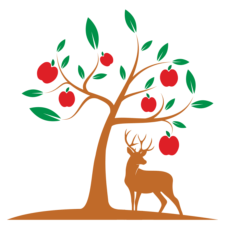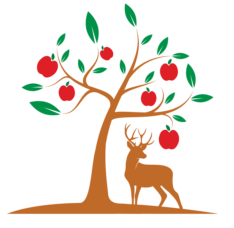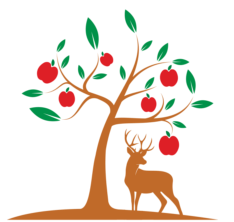(906) 282-3158
Iron Mountain, MI
Home | About Us | Contact Us | Order Trees | Our Products | Tips
N3700 Motts Landing Dr. Iron Mountain, MI 49801
Phone: (906) 282-3158 | Email: greg@n40wildapples.com
Website by North Country Website Design.
North Forty
Wild Apple Trees
North Forty
Wild Apple Trees
Planting Tips
Wild Apple Tree Planting Instructions
Tips for Picking a Good Site
Apple trees do best in full sun on well-drained soil. There is an old saying that 'apples don't like wet feet' meaning that they won't tolerate locations that are routinely wet. Deer hunters and property owners practicing Quality Deer Management (QDM) may want to develop a planting strategy that enhances hunting and viewing opportunities taking into consideration bedding areas, other food sources in the area and the natural travel routes between them. Natural or man-made clearings in the woods, along woods roads, on agricultural field edges, or on abandoned pastureland make excellent sites. Planting apple trees at the edge of your food plots is also an effective strategy. When planning your planting, consider factors that optimize the tree's eventual fruit-bearing potential. Sites that are higher than the surrounding area enable the cold from a late spring frost to settle away from a blossoming tree. Trees or other natural features that shield apple trees from prevailing storm winds in late summer and early fall keep ripening apples on the tree longer and minimize damage to branches that are weighted with fruit. Apple trees are usually not self-pollinating. If there aren't existing apple trees in the general area, your planting site should be large enough for a minimum of 5-10 apple trees to provide adequate opportunity for simultaneous blossoming and cross-pollination.Preparing the Site is Key
Site preparation is important to ensure your trees do well. This may be the most important --- and most often overlooked --- step in planting apple trees. A simple soil test will determine the PH level and fertilizer requirements for your trees to thrive. Apple trees prefer slightly acidic soil having a PH level near 6.5.Planting is Simple and Easy
Trees should be planted as soon as possible when received. If you're not able to plant your North Forty Wild Apple Trees immediately, leave the trees in the shipping package and simply pour water into the top of the moisture pack shipping package and store in a cool, dark place. They can be stored for several days, but the sooner they are planted the better they will do. To plant, simply dig a hole slightly larger than the root system on the tree; place the tree in the hole; backfill; tamp; and water. Peeling back sod and keeping grass and weed roots from competing with the apple tree root for the first year or two is recommended. A light surface application of 12-0-12 fertilizer in the second year helps the young tree get established.We Recommend Browse Protection
Young apple trees are a favorite food source for deer in the summer and rabbits and field mice in the winter. Trunk wraps and fencing are almost always necessary until the tree is firmly established. Don't give up too soon on a tree that has been heavily browsed or girdled. A healthy, established root system will oftentimes produce new sprouts in the spring.Cluster Planting is Effective and Affordable
A 100-foot roll of 6-foot high welded wire fencing and 8 steel t-posts creates a single circle with a 32-foot diameter that provides affordable browse protection for up to 20 trees. Trees planted using this technique are closely spaced about 6 feet apart allowing for some mortality to occur without diminishing the long-term value of the cluster orchard. Several cluster plantings strategically placed on your property encourage wildlife to travel between them increasing wildlife viewing opportunities and hunter success.


Wild Apple Trees
North Forty
Iron Mountain, MI
Home | About | Contact | Order Trees | Our Products
N3700 Motts Landing Dr. Iron Mountain, MI 49801
Phone: (906) 282-3158
Email: greg@n40wildapples.com
Website by North Country Website Design.
North Forty
Wild Apple Trees
Planting Tips
Wild Apple Tree Planting
Instructions
Tips for Picking a Good Site
Apple trees do best in full sun on well-drained soil. There is an old saying that 'apples don't like wet feet' meaning that they won't tolerate locations that are routinely wet. Deer hunters and property owners practicing Quality Deer Management (QDM) may want to develop a planting strategy that enhances hunting and viewing opportunities taking into consideration bedding areas, other food sources in the area and the natural travel routes between them. Natural or man-made clearings in the woods, along woods roads, on agricultural field edges, or on abandoned pastureland make excellent sites. Planting apple trees at the edge of your food plots is also an effective strategy. When planning your planting, consider factors that optimize the tree's eventual fruit-bearing potential. Sites that are higher than the surrounding area enable the cold from a late spring frost to settle away from a blossoming tree. Trees or other natural features that shield apple trees from prevailing storm winds in late summer and early fall keep ripening apples on the tree longer and minimize damage to branches that are weighted with fruit. Apple trees are usually not self-pollinating. If there aren't existing apple trees in the general area, your planting site should be large enough for a minimum of 5-10 apple trees to provide adequate opportunity for simultaneous blossoming and cross-pollination.Preparing the Site is Key
Site preparation is important to ensure your trees do well. This may be the most important --- and most often overlooked --- step in planting apple trees. A simple soil test will determine the PH level and fertilizer requirements for your trees to thrive. Apple trees prefer slightly acidic soil having a PH level near 6.5.Planting is Simple and Easy
Trees should be planted as soon as possible when received. If you're not able to plant your North Forty Wild Apple Trees immediately, leave the trees in the shipping package and simply pour water into the top of the moisture pack shipping package and store in a cool, dark place. They can be stored for several days, but the sooner they are planted the better they will do. To plant, simply dig a hole slightly larger than the root system on the tree; place the tree in the hole; backfill; tamp; and water. Peeling back sod and keeping grass and weed roots from competing with the apple tree root for the first year or two is recommended. A light surface application of 12-0-12 fertilizer in the second year helps the young tree get established.We Recommend Browse Protection
Young apple trees are a favorite food source for deer in the summer and rabbits and field mice in the winter. Trunk wraps and fencing are almost always necessary until the tree is firmly established. Don't give up too soon on a tree that has been heavily browsed or girdled. A healthy, established root system will oftentimes produce new sprouts in the spring.Cluster Planting is Effective and
Affordable
A 100-foot roll of 6-foot high welded wire fencing and 8 steel t-posts creates a single circle with a 32-foot diameter that provides affordable browse protection for up to 20 trees. Trees planted using this technique are closely spaced about 6 feet apart allowing for some mortality to occur without diminishing the long-term value of the cluster orchard. Several cluster plantings strategically placed on your property encourage wildlife to travel between them increasing wildlife viewing opportunities and hunter success.















